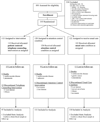Activating peripheral arterial disease patients to reduce cholesterol: a randomized trial
- PMID: 21605733
- PMCID: PMC3225919
- DOI: 10.1016/j.amjmed.2010.11.032
Activating peripheral arterial disease patients to reduce cholesterol: a randomized trial
Abstract
Background: Peripheral arterial disease patients are less likely than other high-risk patients to achieve ideal low-density lipoprotein (LDL) cholesterol levels. This randomized controlled trial assessed whether a telephone counseling intervention, designed to help peripheral arterial disease patients request more intensive cholesterol-lowering therapy from their physician, achieved lower LDL cholesterol levels than 2 control conditions.
Methods: There were 355 peripheral arterial disease participants with baseline LDL cholesterol ≥70 mg/dL enrolled. The primary outcome was change in LDL cholesterol level at 12-month follow-up. There were 3 parallel arms: telephone counseling intervention, attention control condition, and usual care. The intervention consisted of patient-centered counseling, delivered every 6 weeks, encouraging participants to request increases in cholesterol-lowering therapy from their physician. The attention control condition consisted of telephone calls every 6 weeks providing information only. The usual care condition participated in baseline and follow-up testing.
Results: At 12-month follow-up, participants in the intervention improved their LDL cholesterol level, compared with those in attention control (-18.4 mg/dL vs -6.8 mg/dL, P=.010) but not compared with those in usual care (-18.4 mg/dL vs -11.1 mg/dL, P=.208). Intervention participants were more likely to start a cholesterol-lowering medication or increase their cholesterol-lowering medication dose than those in the attention control (54% vs 18%, P=.001) and usual care (54% vs 31%, P <.001) conditions.
Conclusion: Telephone counseling that helped peripheral arterial disease patients request more intensive cholesterol-lowering therapy from their physician achieved greater LDL cholesterol decreases than an attention control arm that provided health information alone.
Trial registration: ClinicalTrials.gov NCT00217919.
Copyright © 2011 Elsevier Inc. All rights reserved.
Conflict of interest statement
Figures
Comment in
-
When it comes to reducing cholesterol, not all statins are the same.Am J Med. 2012 Jan;125(1):e13; author reply e15-6. doi: 10.1016/j.amjmed.2011.07.023. Am J Med. 2012. PMID: 22195539 No abstract available.
References
-
- Heald CL, Fowkes FG, Murray GD, Price JF. Ankle brachial index collaboration. Atherosclerosis. 2006;189:61–69. - PubMed
-
- Heart Protection Study Collaborative group. MRC/BHF Heart protection study of cholesterol lowering with simvastatin in 20,536 high-risk individuals: A randomized placebo-controlled trial. Lancet. 2002;360:7–22. - PubMed
-
- Waters DD, Brotons C, Chiang CW, et al. Lipid Treatment Assessment Project 2: A multinational survey to evaluate the proportion of patients achieving low density lipoprotein cholesterol goals. Circulation. 2009;120:28–34. - PubMed
Publication types
MeSH terms
Substances
Associated data
Grants and funding
LinkOut - more resources
Full Text Sources
Medical


